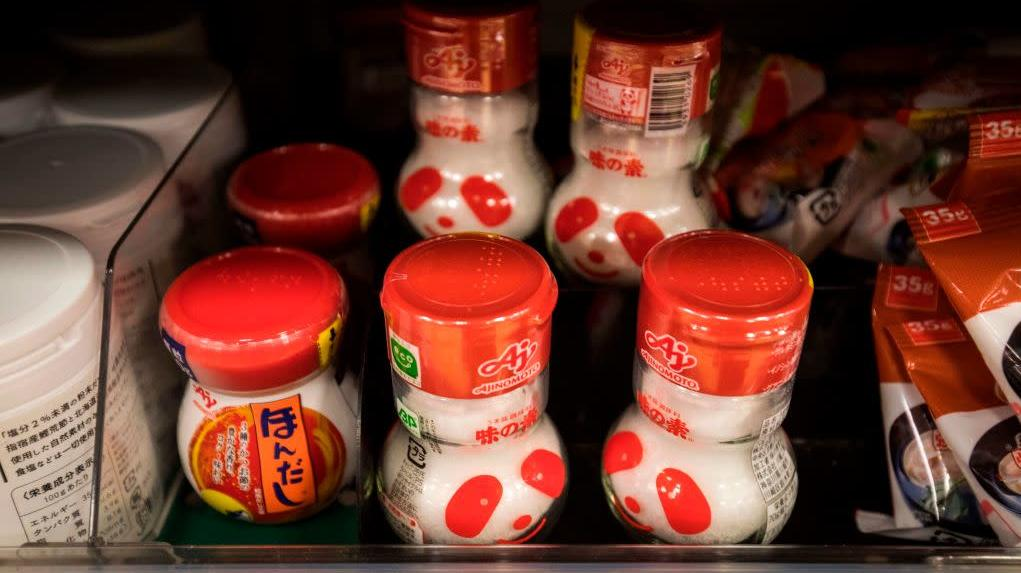MSG Is A Valuable Kitchen Staple, If You Know How To Use It
We may receive a commission on purchases made from links.
For many years the five ingredients that have always sat within easy reach of my stove are salt, pepper, olive oil, vegetable oil, and peanut oil. Recently, a sixth ingredient has snuck into the mix, one that I find increasingly valuable: MSG.
Few cooking ingredients are as polarizing, or widely used, as monosodium glutamate (MSG). According to food historian and scientist Harold McGee, in 1908 a Japanese chemist named Kikunae Ikeda discovered that kombu, a form of seaweed that remains an essential component of Japanese cooking today, is a rich source of monosodium glutamate. It was Ikeda who coined the term umami (which roughly translates from Japanese as "savory") and recognized that glutamates—a type of amino acid responsible for the savory, almost meaty flavor of MSG—are also present in a host of other foods, including meat and cheese. One year after Ikeda's discovery the Ajinomoto company began selling crystalized MSG, refined from wheat gluten, as a stand-alone seasoning.
In the 1960s, as Chinese restaurants began to grow in popularity in the United States, people began to attribute MSG consumption to a host of physical ailments, including headache and nausea. Those symptoms were described as "Chinese Restaurant Syndrome" (CRS) in a letter to the editor published by the New England Journal of Medicine in 1968. Since then MSG has become a cooking boogeyman, despite the fact that there isn't conclusive research connecting MSG to the symptoms people have ascribed to it.
More recently there's been a backlash against people who claim to have MSG sensitivity, powered both by folks like Anthony Bourdain and by Ajinomoto itself, which hosted the pro-MSG World Umami Forum and the "#RedefineCRS" campaign. And while the term itself is absolutely problematic, it's truly hard to say what might be responsible for reports of MSG sensitivity. For example, for years people claiming to be "gluten sensitive" (but not diagnosed with Celiac disease) were said to be essentially imagining their symptoms, and they were ultimately vindicated. And chef and writer J. Kenji López-Alt, author of the award-winning book The Food Lab, told The Takeout, "I don't think that everyone who claims to have MSG Symptom Complex is lying or experiencing some psychosomatic result, and I think it's very likely that some people are indeed sensitive to MSG under certain, heretofore uncatalogued circumstances."
The thing is, just because a label doesn't list MSG as an ingredient doesn't mean that it's not there. Whether or not you've ever used it in its crystalized form, chances are you're already deliberately cooking with it. Many ingredients people add to their cooking to bump up flavor—anchovies, soy sauce, marmite, dried mushrooms, and tomato paste—are rich sources of glutamic acid (MSG). And while the USDA requires that foods made with MSG must list it as an ingredient on labeling, they also make an exception if the product's glutamates are derived from yeast. Many products, such as beef stock, include "yeast extract" (or something similarly named), which has all the same flavor benefits as manufactured MSG, but doesn't carry the stigma of the MSG labeling.
Because of the controversy surrounding MSG sensitivity, recipe writers and chefs will bend over backwards to use glutamate-rich foods in their cooking instead of just recommending that people use a few sprinkles of MSG. Some chefs are open about this and some aren't. Danny Bowien, who appeared on season six of Mind of a Chef, writes in The Mission Chinese Food Cookbook that he pulverizes kombu and dried shiitake mushrooms to make what he calls "the gentleman's MSG."
If all of this makes you wonder whether you should be using MSG in your cooking, the answer is that it depends on what you're trying to do and what kind of ingredients you have access to right now. Using glutamate-rich foods like anchovies, tomatoes, and soy sauce adds flavor that extends beyond a simple boost of MSG, and for people who attribute their sensitivity to the use of crystalized MSG it potentially removes questions about whether they'll have a negative reaction. At the same time, a bag of MSG is cheap, will last forever, and is easy to find at basically any Asian grocer.
It is important to remember MSG isn't a miracle product. "I think it's useful in the same way that salt and refined sugar are useful," says López-Alt. He also says that if you are interested in using crystalized MSG you should start with around 1/2 teaspoon per quart of liquid and, as with using salt, add it to taste until you've reached a point where you're satisfied.
"It's not a magic ingredient or a cure-all when your dish lacks flavor, but it can help punch up umami to balance flavors in the same way that sugar can balance heat," López-Alt says. "Like sugar and salt, it's also a little one-dimensional, so frequently if I can find a natural source of glutamates that come with other flavors (like soy sauce or fish sauce or miso), and it makes sense in the dish, I'd rather use that."
